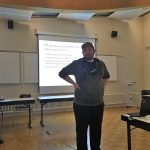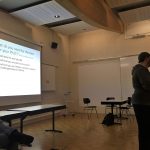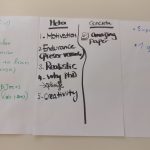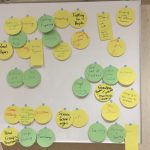 Stefan Schneegass Stefan Schneegass |
 slides slides |
 Mon, 12.03.2018 Mon, 12.03.2018 |
|---|
In this session, Prof. Schneegass discussed the vision behind selecting research topics and selecting a PhD topic. Through brainstorming group activities, we identified key requirements for getting a PhD. We discussed the perspective difference about requirements between PhD holders and PhD students.
Session protocol
- Research becomes monotone and less creative
- The focus of some paper is very specialized -> Researching is only applicable to a special interest group.
Activity 1: Brainstorming – Things required for PhD
- Time
- Developed resistance/skills to failure -> improve from failures
- Supervisor who supervises
- Creativity
- Intrinsic motivation
- Friends as subjects
- Publishing papers at a conference
- Write a thesis
- A substantial contribution to science
- Recognized by your peers
- Finding a research question
- Methodology
- Publication and conferences
- Network talks and coffee
- Convince experts to give you one
- Managing Research
- Passion/Curiosity
- Supervisor which is willing to supervise your PhD
- At least ONE good paper
Academia vs. Industry: Relevant qualifications
- Develop a story for your job talk
- Show that you are able to do research on your own
- Be adaptable and open to new challenges
- Be aware and visible of your research community
- Get to know how conference (and general scientific) venues work
- One single high-quality paper (ToCHI) may be enough for PhD, but not sufficient for the academic position
- Cumulative vs. Monographic thesis:
- Pro Cumulative: People need to publish -> Publications are pushed
- Contra: Published paper cannot be changed -> no reflection and changes in cumulative papers
- Contra: Monographic thesis foster self-plagiarism
Activity 2: Brainstorming – How to generate new ideas
- Read
- Discuss the idea
- Be open to new ideas
- Reflect past experiences
- Leave the bubble
- Wheel of everyday interaction
- Design thinking and brainstorming
- Double diamond model (iterate on one idea)
- Group work
- Generating ideas from different research/activity domains
- Watch Sci-Fi movies
- Keeping an open eye for problems
- Design cards
- working and playing with artifact
- prototyping
- Getting exposed to other expert discussions
- Daydreaming
- Talk to People
- Get a shower
- Text notebook (write ideas down)
- Creativity requires working on an inspiring research topic
- Iterating the idea (what could you do with X)
- Everybody has expertise in different areas; Combine unique expertise
Ideas might be risky
- Does it work?
- Does the user like it?
- Does the reviewer like it?
- High-risk high impact
How many papers do people read?
- Some universities expect them to read 140 papers (examined with a test)
- Most papers professionals read don’t get published



